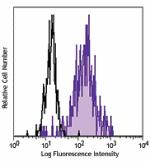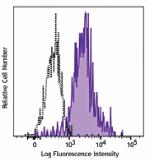- Clone
- 15-414 (See other available formats)
- Regulatory Status
- RUO
- Other Names
- BIT, MFR, P84, MYD-1, SHPS1, PTPNS1, CD172 antigen-like family member A
- Isotype
- Mouse IgG2a, κ
- Barcode Sequence
- CGTGTTTAACTTGAG
| Cat # | Size | Price | Quantity Check Availability | ||
|---|---|---|---|---|---|
| 372113 | 10 µg | $369.00 | |||
CD172a, also known as signal-regulatory protein α (SIRPα), is a 85-90 kD, type I transmembrane protein with one V-set Ig-like and two C-set Ig-like domains in the extracellular portion, and two ITIM motifs and a proline-rich region in the cytoplasmic tail. SIRPα is involved in the negative regulation of receptor tyrosine kinase-coupled signaling; the phospho-tyrosine residues of this protein recruit SH2 domain-containing tyrosine phosphatases (PTP), and serve as substrates of PTPs. CD172a is primarily expressed on monocytes/macrophages, granulocytes, dendritic cells, neurons and by cardiomyocytes derived from human pluripotent stem cells. The ligands of CD172a are CD47, SP-A, and SP-D.
Product Details
- Verified Reactivity
- Human
- Antibody Type
- Monoclonal
- Host Species
- Mouse
- Immunogen
- KG1a cells.
- Formulation
- Phosphate-buffered solution, pH 7.2, containing 0.09% sodium azide and EDTA
- Preparation
- The antibody was purified by chromatography and conjugated with TotalSeq™-B oligomer under optimal conditions.
- Concentration
- 0.5 mg/mL
- Storage & Handling
- The antibody solution should be stored undiluted between 2°C and 8°C. Do not freeze.
- Application
-
PG - Quality tested
- Recommended Usage
-
Each lot of this antibody is quality control tested by immunofluorescent staining with flow cytometric analysis and the oligomer sequence is confirmed by sequencing. TotalSeq™-B antibodies are compatible with 10x Genomics Single Cell Gene Expression Solutions.
To maximize performance, it is strongly recommended that the reagent be titrated for each application, and that you centrifuge the antibody dilution before adding to the cells at 14,000xg at 2 - 8°C for 10 minutes. Carefully pipette out the liquid avoiding the bottom of the tube and add to the cell suspension. For Proteogenomics analysis, the suggested starting amount of this reagent for titration is ≤ 1.0 µg per million cells in 100 µL volume. Refer to the corresponding TotalSeq™ protocol for specific staining instructions.
Buyer is solely responsible for determining whether Buyer has all intellectual property rights that are necessary for Buyer's intended uses of the BioLegend TotalSeq™ products. For example, for any technology platform Buyer uses with TotalSeq™, it is Buyer's sole responsibility to determine whether it has all necessary third party intellectual property rights to use that platform and TotalSeq™ with that platform. - Additional Product Notes
-
TotalSeq™ reagents are designed to profile protein levels at a single cell level following an optimized protocol similar to the CITE-seq workflow. A compatible single cell device (e.g. 10x Genomics Chromium System and Reagents) and sequencer (e.g. Illumina analyzers) are required. Please contact technical support for more information, or visit biolegend.com/totalseq.
The barcode flanking sequences are GTGACTGGAGTTCAGACGTGTGCTCTTCCGATCTNNNNNNNNNN (PCR handle), and NNNNNNNNNGCTTTAAGGCCGGTCCTAGC*A*A (capture sequence). N represents either randomly selected A, C, G, or T, and * indicates a phosphorothioated bond, to prevent nuclease degradation.
View more applications data for this product in our Scientific Poster Library. -
Application References
(PubMed link indicates BioLegend citation) -
- Majdic O, et al. 1981. Blood. 58:1127.
- RRID
-
AB_2876699 (BioLegend Cat. No. 372113)
Antigen Details
- Structure
- Type I transmembrane protein, 85-90 kD, one V-set Ig-like and two C-set Ig-like domains in the extracellular portion, two ITIM motifs and a proline-rich region in the cytoplasmic tail.
- Distribution
-
Monocytes, macrophages, granulocytes, dendritic cells, neurons and by cardiomyocytes derived from human pluripotent stem cells.
- Function
- Negative regulation of receptor tyrosine kinase-coupled signaling, mediates macrophage multinucleation, involved in neuronal survival.
- Ligand/Receptor
- CD47, SP-A, and SP-D.
- Cell Type
- Dendritic cells, Granulocytes, Macrophages, Monocytes, Neurons
- Biology Area
- Cell Biology, Immunology, Neuroscience Cell Markers
- Molecular Family
- CD Molecules
- Antigen References
-
1. Lv Z, et al. 2015. J. Immunol. 195:661.
2. Hatherley D, et al. 2014. J. Biol. Chem. 289:10024.
3. Zen K, et al. 2013. Nat. Commun. 4:2436.
4. Baba N, et al. 2013. J. Exp. Med. 210:1251.
5. Barclay AN, Brown MH. 2006. Nat. Rev. Immunol. 6:457. - Gene ID
- 140885 View all products for this Gene ID
- UniProt
- View information about CD172alpha on UniProt.org
Other Formats
View All CD172a (SIRPα) Reagents Request Custom Conjugation| Description | Clone | Applications |
|---|---|---|
| Purified anti-human CD172a (SIRPα) | 15-414 | FC |
| PE anti-human CD172a (SIRPα) | 15-414 | FC |
| APC anti-human CD172a (SIRPα) | 15-414 | FC |
| FITC anti-human CD172a (SIRPα) | 15-414 | FC |
| TotalSeq™-A0408 anti-human CD172a (SIRPα) | 15-414 | PG |
| TotalSeq™-C0408 anti-human CD172a (SIRPα) | 15-414 | PG |
| TotalSeq™-B0408 anti-human CD172a (SIRPα) | 15-414 | PG |
| TotalSeq™-D0408 anti-human CD172a (SIRPα) | 15-414 | PG |
Compare Data Across All Formats
This data display is provided for general comparisons between formats.
Your actual data may vary due to variations in samples, target cells, instruments and their settings, staining conditions, and other factors.
If you need assistance with selecting the best format contact our expert technical support team.
-
Purified anti-human CD172a (SIRPα)

Human peripheral blood monocytes were stained with purified ... -
PE anti-human CD172a (SIRPα)

Human peripheral blood monocytes were stained with CD172a (c... -
APC anti-human CD172a (SIRPα)

Human peripheral blood monocytes were stained with CD172a (c... -
FITC anti-human CD172a (SIRPα)

Human peripheral blood monocytes were stained with CD172a (c... -
TotalSeq™-A0408 anti-human CD172a (SIRPα)
-
TotalSeq™-C0408 anti-human CD172a (SIRPα)
-
TotalSeq™-B0408 anti-human CD172a (SIRPα)
-
TotalSeq™-D0408 anti-human CD172a (SIRPα)
